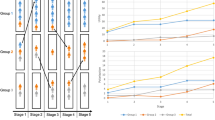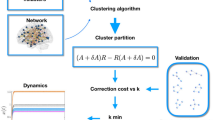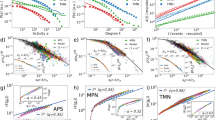Abstract
The rich set of interactions between individuals in society1,2,3,4,5,6,7 results in complex community structure, capturing highly connected circles of friends, families or professional cliques in a social network3,7,8,9,10. Thanks to frequent changes in the activity and communication patterns of individuals, the associated social and communication network is subject to constant evolution7,11,12,13,14,15,16. Our knowledge of the mechanisms governing the underlying community dynamics is limited, but is essential for a deeper understanding of the development and self-optimization of society as a whole17,18,19,20,21,22. We have developed an algorithm based on clique percolation23,24 that allows us to investigate the time dependence of overlapping communities on a large scale, and thus uncover basic relationships characterizing community evolution. Our focus is on networks capturing the collaboration between scientists and the calls between mobile phone users. We find that large groups persist for longer if they are capable of dynamically altering their membership, suggesting that an ability to change the group composition results in better adaptability. The behaviour of small groups displays the opposite tendency—the condition for stability is that their composition remains unchanged. We also show that knowledge of the time commitment of members to a given community can be used for estimating the community’s lifetime. These findings offer insight into the fundamental differences between the dynamics of small groups and large institutions.
This is a preview of subscription content, access via your institution
Access options
Subscribe to this journal
Receive 51 print issues and online access
$199.00 per year
only $3.90 per issue
Buy this article
- Purchase on Springer Link
- Instant access to full article PDF
Prices may be subject to local taxes which are calculated during checkout




Similar content being viewed by others
References
Watts, D. J. & Strogatz, S. H. Collective dynamics of ‘small-world’ networks. Nature 393, 440–442 (1998)
Barabási, A.-L. & Albert, R. Emergence of scaling in random networks. Science 286, 509–512 (1999)
Scott, J. Social Network Analysis: A Handbook 2nd edn (Sage Publications, London, 2000)
Dorogovtsev, S. N. & Mendes, J. F. F. Evolution of Networks: From Biological Nets to the Internet and WWW. (Oxford Univ. Press, Oxford, 2003)
Watts, D. J., Dodds, P. S. & Newman, M. E. J. Identity and search in social networks. Science 296, 1302–1305 (2002)
Faust, K. in Models and Methods in Social Network Analysis (eds Carrington, P., Scott, J. & Wasserman, S.) Ch. 7 (Cambridge Univ. Press, New York, 2005)
Liljeros, F., Edling, R., Amaral, L. A. N., Stanley, H. E. & Aberg, Y. The web of human sexual contacts. Nature 411, 907–908 (2001)
Shiffrin, R. M. & Börner, K. Mapping knowledge domains. Proc. Natl Acad. Sci. USA 101, (suppl. 1)5183–5185 (2004)
Newman, M. E. J. Detecting community structure in networks. Eur. Phys. J. B 38, 321–330 (2004)
Radicchi, F., Castellano, C., Cecconi, F., Loreto, V. & Parisi, D. Defining and identifying communities in networks. Proc. Natl Acad. Sci. USA 101, 2658–2663 (2004)
Barabási, A.-L. et al. Evolution of the social network of scientific collaborations. Physica A 311, 590–614 (2002)
Holme, P., Edling, R. & Liljeros, F. Structure and time-evolution of an internet dating community. Soc. Networks 26, 155–174 (2004)
Ebel, H., Davidsen, J. & Bornholdt, S. Dynamics of social networks. Complexity 8, 24–27 (2002)
Wagner, C. S. & Leydesdorff, L. Network structure, self-organization, and the growth of international collaboration in science. Res. Policy 34, 1608–1618 (2005)
Yeung, Y.-Y., Liu, T. C.-Y. & Ng, P.-H. A social network analysis of research collaboration in physics education. Am. J. Phys. 73, 145–150 (2005)
Newman, M. E. J. & Park, J. Why social networks are different from other types of networks. Phys. Rev. E 68, 036122 (2003)
Guimerá, R., Danon, L., Diaz-Guilera, A., Giralt, F. & Arenas, A. Self-similar community structure in organisations. Phys. Rev. E 68, 065103 (2003)
Hopcroft, J., Khan, O., Kulis, B. & Selman, B. Tracking evolving communities in large linked networks. Proc. Natl Acad. Sci. USA 101, 5249–5253 (2004)
Guimerá, R., Uzzi, B., Spiro, J. & Amaral, L. A. N. Team assembly mechanisms determine collaboration network structure and team performance. Science 308, 697–702 (2005)
Li & Maini, K. An evolving network model with community structure. J. Phys. Math. Gen. 38, 9741–9749 (2005)
Pollner, P., Palla, G. & Vicsek, T. Preferential attachment of communities: The same principle, but a higher level. Europhys. Lett. 73, 478–484 (2006)
Kossinets, G. & Watts, D. J. Empirical analysis of an evolving social network. Science 311, 88–90 (2006)
Palla, G., Derényi, I., Farkas, I. & Vicsek, T. Uncovering the overlapping community structure of complex networks in nature and society. Nature 435, 814–818 (2005)
Derényi, I., Palla, G. & Vicsek, T. Clique percolation in random networks. Phys. Rev. Lett. 94, 160202 (2005)
Warner, S. E-prints and the open archives initiative. Library Hi Tech 21, 151–158 (2003)
Granovetter, M. S. The strength of weak ties. Am. J. Sociol. 78, 1360–1380 (1973)
Csermely, P. Weak Links (Springer, Heidelberg, 2006)
Onnela, J.-P. et al. Structure and tie strengths in mobile communication networks. Preprint at 〈http://lanl.arxiv.org/abs/physics/0610104〉 (2006)
Everett, M. G. & Borgatti, S. P. Analyzing clique overlap. Connections 21, 49–61 (1998)
Acknowledgements
We thank I. Derényi for suggestions, and G. Szabó and I. Farkas for their assistance with the primary phone-call and co-authorship data sets, respectively. G.P and T.V are supported by OTKA; A.-L.B. is supported by the James S. McDonnell Foundation and the National Science Foundation within the DDDAS and ITR programmes.
Author information
Authors and Affiliations
Corresponding author
Ethics declarations
Competing interests
The company that served as the data source for the telephone data offered financial support for consulting and data analysis.
Supplementary information
Supplementary Information
This file contains Supplementary Discussion, Supplementary Figures 1-10 with Legends and additional references. (PDF 542 kb)
Rights and permissions
About this article
Cite this article
Palla, G., Barabási, AL. & Vicsek, T. Quantifying social group evolution. Nature 446, 664–667 (2007). https://doi.org/10.1038/nature05670
Received:
Accepted:
Issue Date:
DOI: https://doi.org/10.1038/nature05670
This article is cited by
-
Adaptive link dynamics drive online hate networks and their mainstream influence
npj Complexity (2024)
-
Expanding students’ social networks via optimized team assignments
Annals of Operations Research (2024)
-
Academic mobility from a big data perspective
International Journal of Data Science and Analytics (2023)
-
Local community detection based on influence maximization in dynamic networks
Applied Intelligence (2023)
Comments
By submitting a comment you agree to abide by our Terms and Community Guidelines. If you find something abusive or that does not comply with our terms or guidelines please flag it as inappropriate.



